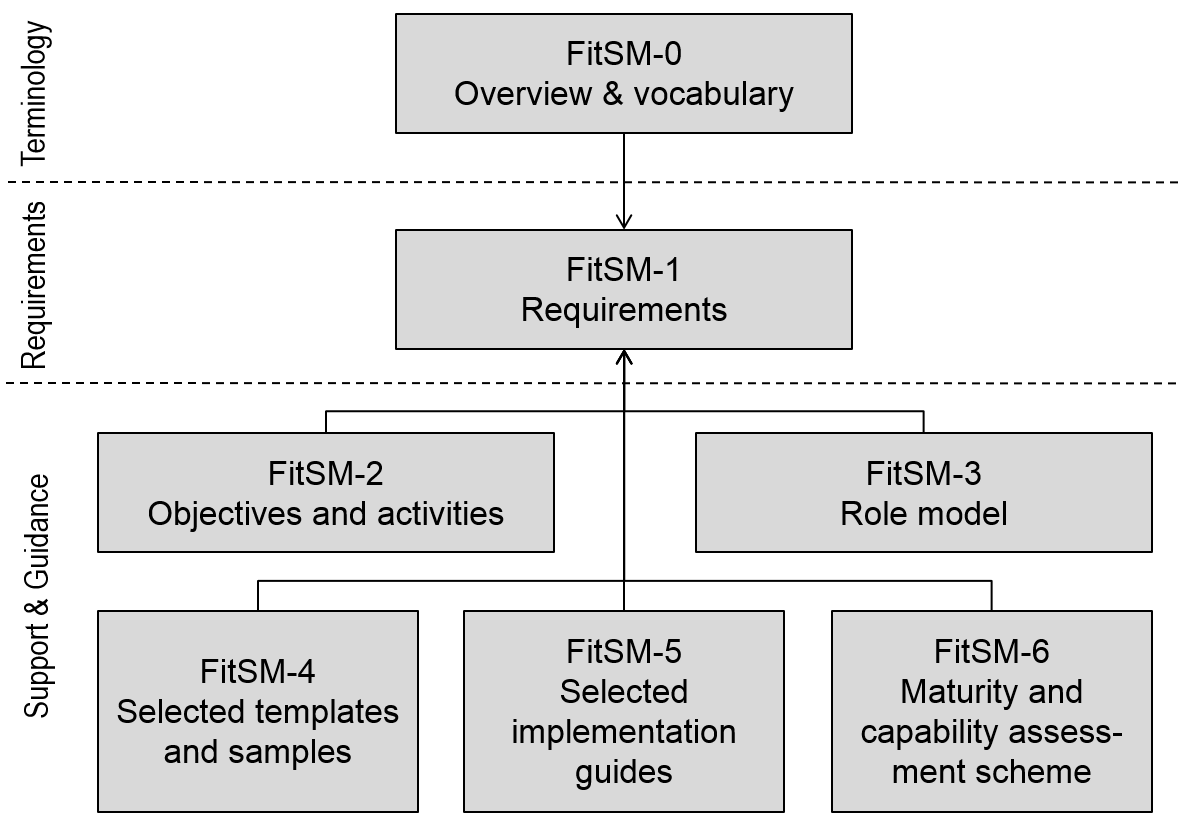FitSM on:
[Wikipedia]
[Google]
[Amazon]
FitSM is the name for a family of standards for lightweight
 FitSM calls itself a
FitSM calls itself a
ITEMO
.
IT service management
Information technology service management (ITSM) is the activities that are performed by an organization to design, build, deliver, operate and control information technology (IT) services offered to customers.
Differing from more technology-or ...
(ITSM).
Overview and parts
 FitSM calls itself a
FitSM calls itself a standard Standard may refer to:
Symbols
* Colours, standards and guidons, kinds of military signs
* Standard (emblem), a type of a large symbol or emblem used for identification
Norms, conventions or requirements
* Standard (metrology), an object th ...
, but is not published or managed by an established standards organisation like ISO
ISO is the most common abbreviation for the International Organization for Standardization.
ISO or Iso may also refer to: Business and finance
* Iso (supermarket), a chain of Danish supermarkets incorporated into the SuperBest chain in 2007
* Iso ...
.
However, in a way very similar to that of many ISO and ISO/IEC standard families, it structures its documents into several numbered parts and defines requirements for an effective service management system in its part 1.
All parts are published under Creative Common licenses.
FitSM-0: Overview and vocabulary
A single document containing about 70 definitions of ITSM terms.FitSM-1: Requirements
A single document containing about 85 auditable requirements for an effective service management system. The requirements are divided into general requirements (GR) and requirements for 14 different service management processes (PR). FitSM is similar in scope and style to part 1 ofISO/IEC 20000
ISO/IEC 20000 is the international standard for IT service management. It was developed in 2005 by ISO/IEC JTC1/SC7 and revised in 2011 and 2018. It was originally based on the earlier BS 15000 that was developed by BSI Group.
ISO/IEC 20000, lik ...
, but significantly shorter.
FitSM-2: Objectives and activities
A single document containing a description of the goal of each process defined in FitSM-1, as well as a description of activities to initially set up the process and ongoing process activities.FitSM-3: Role model
A single document containing descriptions of generic service management system and service management process roles.FitSM-4: Templates and samples
A collection of templates and samples for documents needed in a service management system, e.g. SLAs, statement of a service managementpolicy
Policy is a deliberate system of guidelines to guide decisions and achieve rational outcomes. A policy is a statement of intent and is implemented as a procedure or protocol. Policies are generally adopted by a governance body within an orga ...
, elements of a service portfolio or service catalogue A service catalog (or catalogue), is an organized and curated collection of any and all business and information technology related services that can be performed by, for, or within an enterprise.
Service catalogs act as knowledge management tools ...
etc.
FitSM-5: Guides
A collection of guides on various ITSM topics.FitSM-6: Maturity assessment
An Excel-based tool that uses situation descriptions to aid an easy assessment of the maturity of implemented service management processes and general practices.Certification and qualification scheme
While conformance to FitSM-1 requirements can be audited, there is no certification for conformance. Unlike for ISO/IEC 20000, organizations cannot have their service management system 'FitSM certified'. A qualification and certification scheme for personnel, much like those established forITIL
The Information Technology Infrastructure Library (ITIL) is a set of detailed practices for IT activities such as IT service management (ITSM) and IT asset management (ITAM) that focus on aligning IT services with the needs of business.
ITIL d ...
and ISO/IEC 20000
ISO/IEC 20000 is the international standard for IT service management. It was developed in 2005 by ISO/IEC JTC1/SC7 and revised in 2011 and 2018. It was originally based on the earlier BS 15000 that was developed by BSI Group.
ISO/IEC 20000, lik ...
, but involving fewer and shorter trainings, was started in 2013.
Origin
FitSM is based on deliverables of FedSM, a project funded in the 7th Framework Program for Research and Technological Development by the European Union. The original aim of FedSM was to "increase maturity and effectiveness of Service Management in federated e-Infrastructures by applying suitable good practices." How to establish management processes across federated organizational structures is not considered in traditional ITSM frameworks, and can pose a difficult task when trying to introduce ITSM in E-infrastructures which often distribute the provisioning of services among a federation of peer organizations. However, a much larger challenge to introducing ITSM at FedSM's client organizations turned out be the adaptation of the very comprehensive ITSM guidance described by traditional ITSM frameworks to a set of practices that could realistically be implemented in relatively small organizations within the project lifetime of three years. From May 2013, to foster the beginning interest in FedSM's "lightweight" ITSM guidance by IT organizations from outside the e-Infrastructure community, the project consortium started publishing revised versions project deliverables under the FitSM name. The team members have announced on their project website that the FitSM standard will continue to be maintained in the future within the framework of a working group of IT Education Management OrganisatioITEMO
.
References
{{Reflist IT service management Standards